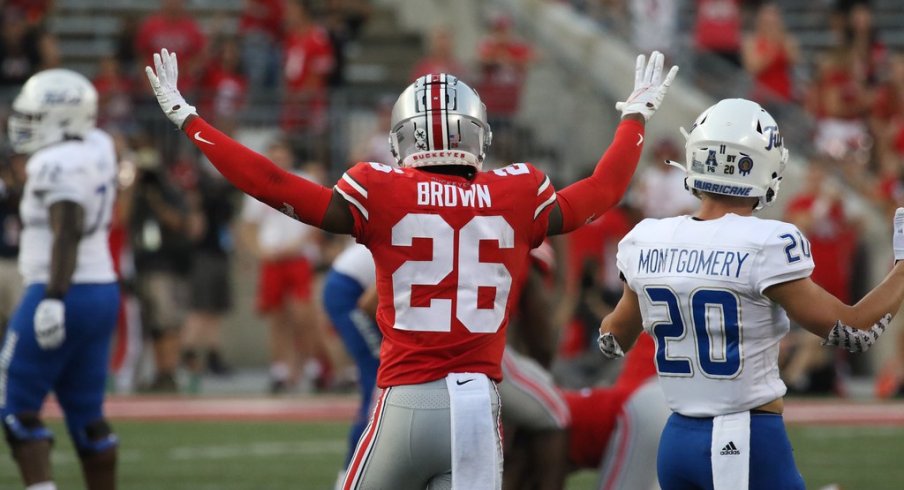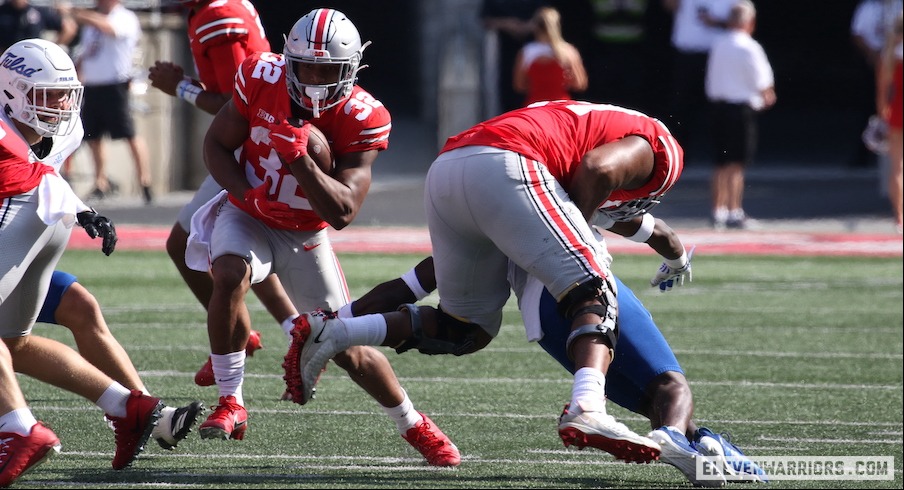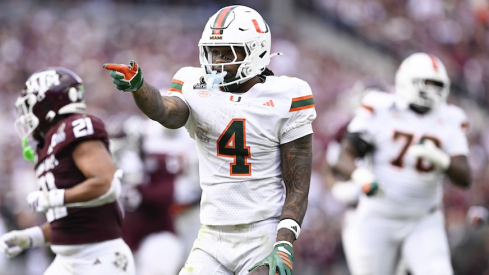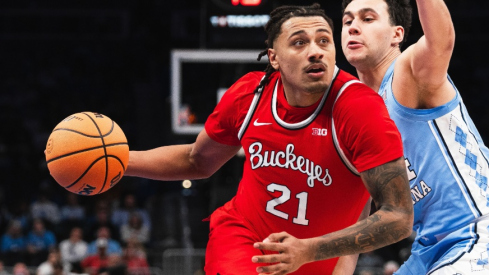After an uninspiring performance against Oregon the week before, it seemed as though the entire state of Ohio was focused on the Buckeye defense on Saturday. Ryan Day promised “structural changes” would be made to a unit that was not only beat from a schematic perspective for the second time in three games but simply failed to execute at a basic level.
As Ohio State took the field against Tulsa, however, it still remained unclear what, exactly those changes might be. We quickly found out that Kerry Coombs and Matt Barnes switched places with the former going up to the press box while the latter called plays from the sideline, but that alone did not tell us anything about the on-field product.
When the Golden Hurricane had the ball for the first time, it was still unclear what, exactly, had changed. Despite the TV announcers repeatedly mentioning the need for the Buckeyes to play with two deep safeties, it didn't actually happen.
Throughout that first Tulsa possession, we saw much of the same defense Ohio State has shown since 2019, as although free safety Bryson Shaw and bullet safety Ronnie Hickman would both line up in a deep alignment, one would often rotate down before the snap as the unit employed a single-high, three-deep coverage.
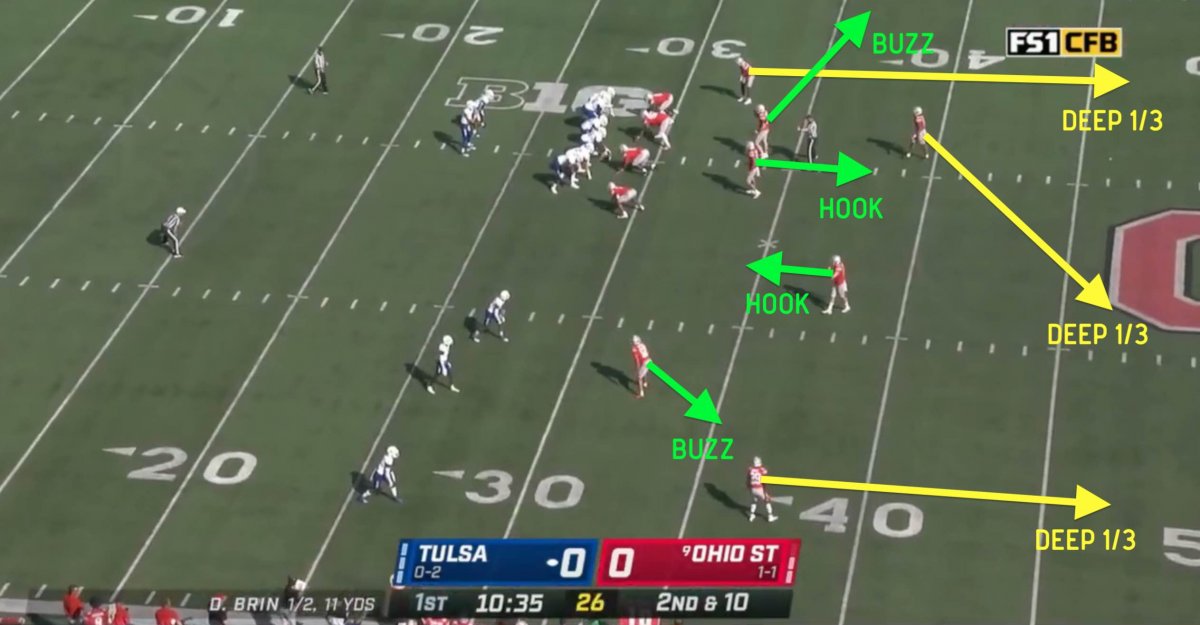
On Tulsa's first drive of the game, which lasted 15 plays and resulted in a field goal, the Buckeyes played a Cover 3 zone on eight of those snaps.
While the Tulsa offense had yet to strike fear in an opponent's heart in 2021, it had no trouble moving the ball much like any other recent Buckeye opponent, getting the same coverages it expected in the passing game.
There was one early notable change in the first two Golden Hurricane possessions, however. Whenever Tulsa was in a likely position to run the football, Barnes often called for his two inside linebackers to blitz through the A-gaps.
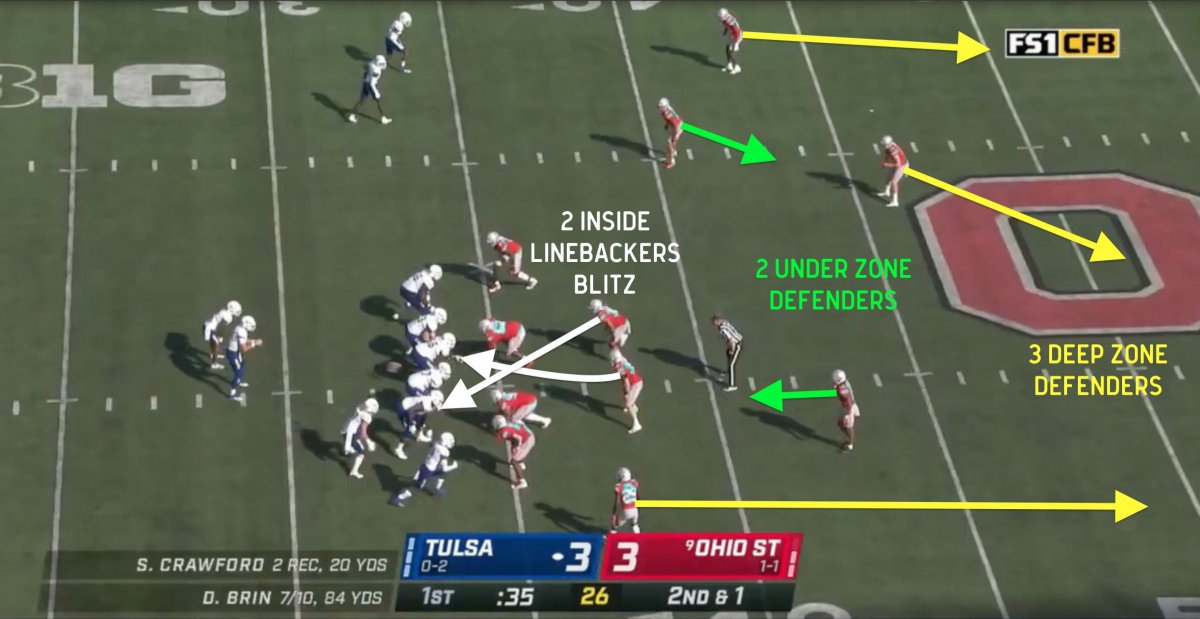
This Crossfire look was a common one from Ohio State, with the first linebacker meant to disrupt interior blocking combinations while the other snuck into the backfield untouched. Behind it, the defense would employ a common zone-blitz coverage, with the free safety and both corners playing three deep zones while the bullet and cover safety manned zones along the hashes, keeping everything in front of them.
The result was noticeable on paper, as the Buckeyes held Tulsa to just 2.6 yards-per-carry, a far cry from the 7.1 surrendered to Oregon the week prior.
"I thought we stopped the run better and I thought we did mix up some of the looks," Day told reporters after the game. "I thought we changed some things up structurally."
But these run blitzes also took the linebackers out of conflict in the RPO game, as the roles of the front six were delineated from the back five in coverage. Tulsa is not a huge RPO team, but given what they saw on film, it was clear that it needed to try and attack the Buckeyes this way.
Thanks to this adjustment, the Golden Hurricane found far less success in this department than recent OSU opponents. With Hickman or Lathan Ransom clearly playing the pass in this 3-deep, 2-under zone, Tulsa QB Davis Brin handed the ball off on nearly every RPO with little room for the ball-carrier to go.
Similarly, the Buckeyes often blitzed those same linebackers on passing downs as well. Behind the pressure, though, the secondary employed man-coverage with just one deep safety, and more often than not, the young cornerbacks and cover safeties looked confident and comfortable making plays in these high leverage situations.
Cam Martinez saw his first real playing time in the secondary, replacing the bullet as an additional slot defender when Tulsa went with four wide receivers. He obviously made quite a splash, combining with cornerbacks Cameron Brown and Denzel Burke to break up seven Tulsa passes.
It's a good thing the secondary proved capable, however, as the Buckeye pass seemed largely non-existent, despite these extra rushers.
"I'd like to see a little bit more of a pass rush," said Day, "We gotta do a better job of making the quarterback uncomfortable."
While many have focused on the lack of an all-world pass rusher like the Bosas or Chase Young, the absences of Jonathon Cooper and Tommy Togiai from a year ago are still being felt up front. With Zach Harrison on the sideline for this game, the Buckeyes were only able to register two sacks and four hurries on 54 Tulsa pass attempts.
But the Buckeyes came out of halftime and forced three straight Tulsa punts by using a new formula of playing straightforward, man-coverage with a free safety behind it (Cover 1) on early downs, before blitzing on third downs. However, the biggest schematic change also came at this point, as we saw real, two-deep coverages added to the mix.
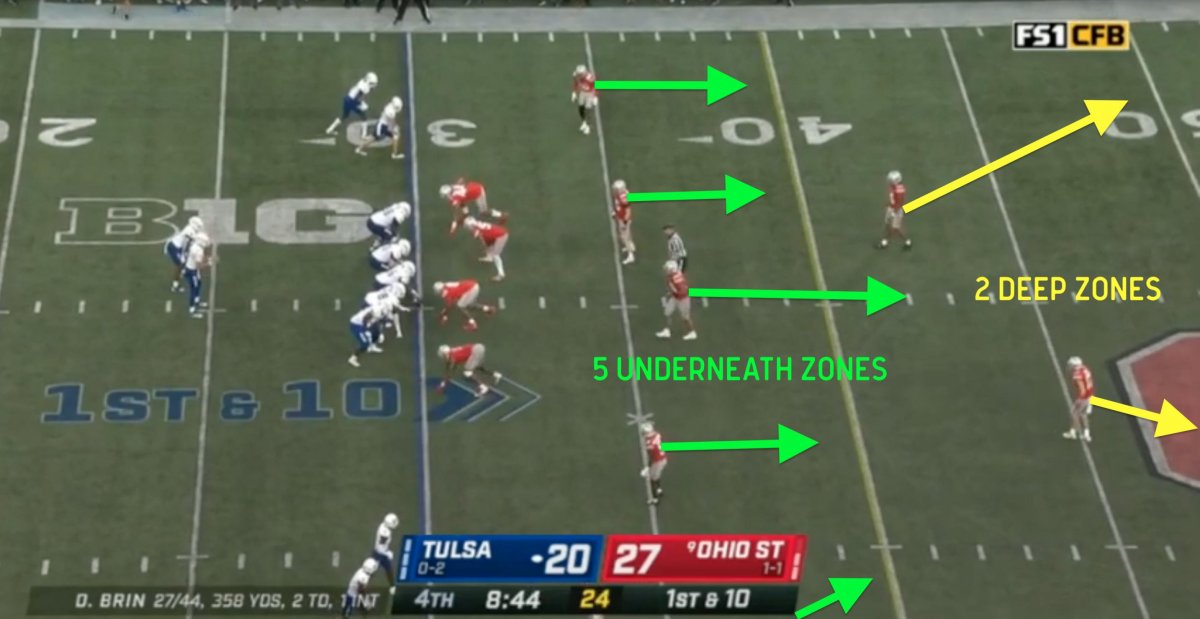
Barnes began calling Cover 2 on early downs, expecting Tulsa to throw the ball underneath. While the coverage is traditionally vulnerable against the run (especially from spread formations), the Golden Hurricane had largely given up trying to do so at this point, making it a safe bet.
While the look is hardly a new one, the simple change-up alone seemed to create some indecision for Brin instead of getting the ball out quickly.
But Philip Montgomery is a good coach, and he began to recognize certain patterns in Barnes' play-calling as the afternoon progressed. When Martinez entered the game against four-wide sets, the Buckeyes played man-coverage almost exclusively, giving Tulsa an opportunity.
By bunching up two or three receivers to one side, it ensured that at least one would get a clean release off the line. But these bunch formations also gave Tulsa the opportunity to set legal picks for one another.
Tulsa's first touchdown of the game came near the end of the third quarter after a Buckeye fumble gave them the ball in OSU territory. On the play, Ransom's man ran directly in the path of Martinez, taking out two defenders while Martinez's man streaked wide open across the field.
Despite playing with different personnel and sending a blitz, Montgomery knew that, eventually, the Buckeyes would get into man-coverage with their backs to their own goal-line, just as they had against Oregon the week prior. While the Ducks used this knowledge to set up multiple crack-sweeps around the left edge with two-for-one blocks, Tulsa did the same thing in the passing game to free up receivers.
As the Golden Hurricane approached the red zone on its next possession, Montgomery had another man-beater ready. This time, the middle receiver in the three-man bunch was the one 'setting a pick' by running a simple hitch route right at the same depth as Ransom.
While Ransom was able to avoid contact with the receiver, his diverted path created enough space for his man to release upfield and gave Brin another open target before the pass rush arrived.
Thanks to a monster performance from Treveyon Henderson, the Buckeyes were able to keep their lead throughout the second half and force Tulsa to play more aggressively than they'd have liked. Eventually, the dam broke and Martinez was able to take a late interception back for six points, cementing the OSU win.
| Concept | % of snaps |
|---|---|
| Cover 1 (Man) | 32.1% |
| Cover 3 (Zone) | 31.0% |
| Man Blitz | 13.1% |
| Zone Blitz | 11.9% |
| Cover 2 (Zone) | 9.5% |
| 2-Man (Man + Zone) | 2.4% |
“We’re gonna watch the film and assess it and go back in there," Day said of the defense's overall performance. “But I think the way the things went today was pretty smooth, and hopefully we can build on it."
There is, indeed much to build on, even if the box score doesn't show it.
Yes, the Buckeyes gave up 501 yards of offense to an unranked, group-of-five program that is still winless this season. But this was the most diverse scheme we've seen from Ohio State's defense in years, with a variety of coverages making their way onto the call sheet in the second half.
Additionally, the unit is still very much a work-in-progress, but it at least has a semblance of an identity upon which everything can build. The outside cornerbacks have been terrific through three games, with opposing QBs completing just 40% of their passes when targeting Brown and Burke this season.
With those two taking away the outside, the defensive staff can continue to experiment with ways to take away passes between the numbers and avoid getting beat by bunch sets. While blitzing the inside linebackers on every play might be a step too far, Barnes, Coombs, and co. now have multiple ways to keep opponents guessing on early downs instead of sitting in a static, single-high alignment every time.
This unit was never going to abandon the basic structure of relying on single-high coverage mid-season, and frankly, it never has to. The core philosophy of what Day wants to achieve is by no means the wrong one to hold.
Taking away the inside run and deep passes outside is a proven recipe for winning football games, and one the Buckeyes can still hope to achieve. But there is still much work to be done.
Whether by finding the right combination of pass rushers or by continuing to mix in new blitzes, the Buckeyes must find a way to create pressure more effectively. Additionally, whoever is calling plays must work to avoid settling into predictable tendencies that can later be exploited.
Ohio State showed enough from a schematic standpoint to keep offenses guessing, knowing that its best bet is to get in man-coverage and rely on its talented corners to make a play. But where and when the other concepts are called will go a long way in determining how successful this defense can ultimately be.
- #9 Ohio State 41, TULSA 20
- • Ohio State survives a scare against Tulsa
- • treveyon Henderson bailed out the buckeye offense.
- • matt barnes will likely continue to call defensive plays
- • C.j. stroud is confident despite criticism and his injury
- • OHIO STATE POSTGAME • notebook • quotebook
- • PHOTOS • Five things • debriefing • social reax • three key stats
